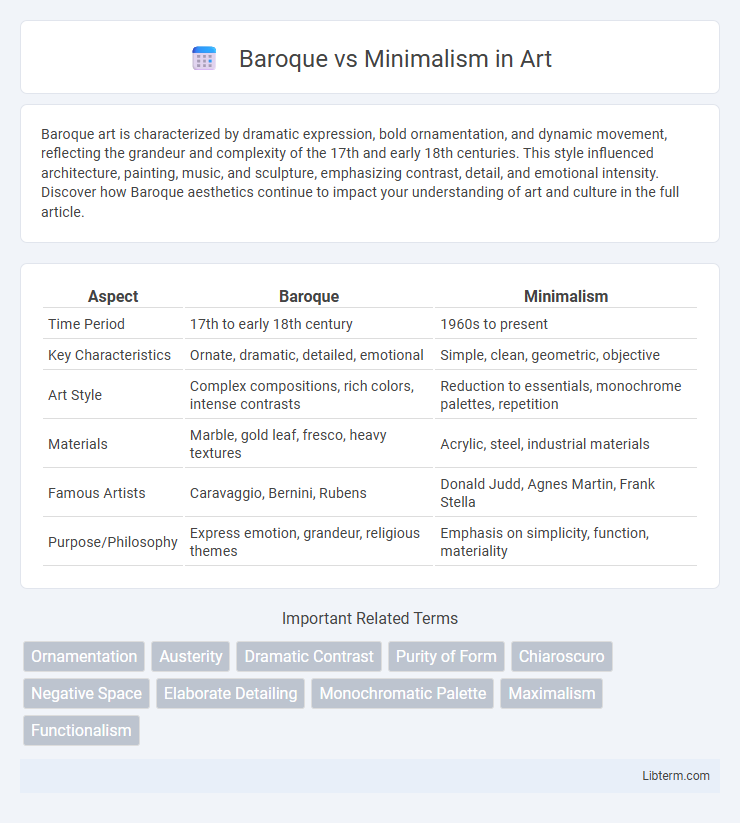Baroque art is characterized by dramatic expression, bold ornamentation, and dynamic movement, reflecting the grandeur and complexity of the 17th and early 18th centuries. This style influenced architecture, painting, music, and sculpture, emphasizing contrast, detail, and emotional intensity. Discover how Baroque aesthetics continue to impact your understanding of art and culture in the full article.
Table of Comparison
| Aspect | Baroque | Minimalism |
|---|---|---|
| Time Period | 17th to early 18th century | 1960s to present |
| Key Characteristics | Ornate, dramatic, detailed, emotional | Simple, clean, geometric, objective |
| Art Style | Complex compositions, rich colors, intense contrasts | Reduction to essentials, monochrome palettes, repetition |
| Materials | Marble, gold leaf, fresco, heavy textures | Acrylic, steel, industrial materials |
| Famous Artists | Caravaggio, Bernini, Rubens | Donald Judd, Agnes Martin, Frank Stella |
| Purpose/Philosophy | Express emotion, grandeur, religious themes | Emphasis on simplicity, function, materiality |
Introduction to Baroque and Minimalism
Baroque music, originating in the early 17th century, is characterized by its ornate complexity, dramatic contrasts, and expressive ornamentation, exemplified by composers like Johann Sebastian Bach and Antonio Vivaldi. Minimalism emerged in the mid-20th century as a reaction against such complexity, emphasizing simplicity, repetition, and gradual transformation, with pioneers such as Steve Reich and Philip Glass. These contrasting styles reflect fundamentally different approaches to musical structure, texture, and emotional expression.
Historical Origins and Development
Baroque art and music originated in the early 17th century Europe, characterized by ornate detail, dramatic intensity, and emotional exuberance, reflecting the cultural and religious upheavals of the Counter-Reformation. Minimalism emerged in the late 1950s and 1960s in the United States as a reaction against the complexity of Abstract Expressionism, emphasizing simplicity, repetition, and stripped-down forms to highlight pure expression. The historical development of Baroque intertwined with royal patronage and church commissions, while Minimalism grew out of modernist ideologies and a desire to reject traditional aesthetics.
Key Characteristics of Baroque Style
Baroque style features dramatic contrasts, intricate details, and dynamic movement, often expressed through bold ornamentation and elaborate decoration. Its key characteristics include grandeur, emotional intensity, and a strong sense of rhythm created by curved lines and rich textures. Baroque architecture and art emphasize tension and energy, using techniques such as chiaroscuro and complex compositions to evoke awe and grandeur.
Defining Features of Minimalism
Minimalism is characterized by simplicity, clean lines, and a monochromatic palette that emphasizes form and function over ornamentation. It focuses on space, light, and materials, often using repetition and geometric shapes to create a sense of order and tranquility. Unlike Baroque's elaborate detail and dramatic contrasts, minimalism seeks to eliminate excess, promoting clarity and calmness in design.
Influential Artists and Architects
Baroque influential artists include Gian Lorenzo Bernini and Caravaggio, whose dramatic expressions and intricate details defined the grandeur of 17th-century art and architecture, exemplified in structures like St. Peter's Basilica. Minimalism features pioneers such as Donald Judd and Agnes Martin, emphasizing simplicity and geometric forms that strip away excess, influencing modern architecture through the works of Ludwig Mies van der Rohe and Tadao Ando. These contrasting styles showcase Baroque's ornate complexity versus Minimalism's clean lines and functional design, each shaping art and architectural history with distinct philosophical principles.
Color, Form, and Materials
Baroque design embraces rich, opulent colors such as deep golds, reds, and blues, with intricate, curvilinear forms that create dramatic visual complexity, often utilizing luxurious materials like marble, gilt, and velvet. Minimalism emphasizes a restrained color palette of whites, blacks, and neutrals, favoring geometric, simple forms that highlight functionality and clarity, frequently employing materials such as glass, steel, and concrete to maintain purity and minimal ornamentation. The contrast between Baroque's elaborate textures and diverse materials versus Minimalism's smooth surfaces and limited color spectrum defines their distinct aesthetic and philosophical approaches.
Emotional Impact and Audience Experience
Baroque music, characterized by intricate melodies and dramatic contrasts, evokes intense emotional responses through its complex harmonies and dynamic tension, immersing audiences in a rich, expressive soundscape. Minimalism emphasizes repetition and gradual variation, creating a hypnotic and meditative atmosphere that invites deep introspection and sustained focus from listeners. The emotional impact of Baroque music often feels heightened and theatrical, while Minimalism provides a calming, contemplative experience, appealing to different facets of audience engagement.
Baroque vs Minimalism in Modern Design
Baroque and Minimalism in modern design represent contrasting approaches to aesthetics and function, where Baroque emphasizes ornate details, rich textures, and layered complexity, creating dramatic visual impact and a sense of grandeur. Minimalist design prioritizes simplicity, clean lines, and functional elements, focusing on space efficiency and clarity to evoke calm and order. The fusion of these styles in contemporary interiors often highlights the tension between opulence and restraint, influencing trends in architecture, furniture, and digital interfaces.
Popular Examples in Art and Architecture
Baroque art and architecture are exemplified by Bernini's St. Peter's Basilica and Caravaggio's dramatic paintings, characterized by intricate details, dynamic movement, and ornate decorations. Minimalism is showcased in the works of architect Ludwig Mies van der Rohe, such as the Barcelona Pavilion, and artist Donald Judd's geometric sculptures, emphasizing simplicity, clean lines, and functional forms. The contrast reflects Baroque's emotional exuberance versus Minimalism's focus on clarity and spatial purity.
Choosing Between Baroque and Minimalism Today
Choosing between Baroque and Minimalism today involves balancing ornate detail with simplicity to match modern tastes and functional needs. Baroque's intricate designs and dramatic elements suit spaces seeking grandeur and historical richness, while Minimalism's clean lines and uncluttered aesthetics align with contemporary preferences for calm and efficiency. Decision-makers should consider personal style, spatial constraints, and desired emotional impact to optimize interior or artistic environments effectively.
Baroque Infographic

 libterm.com
libterm.com